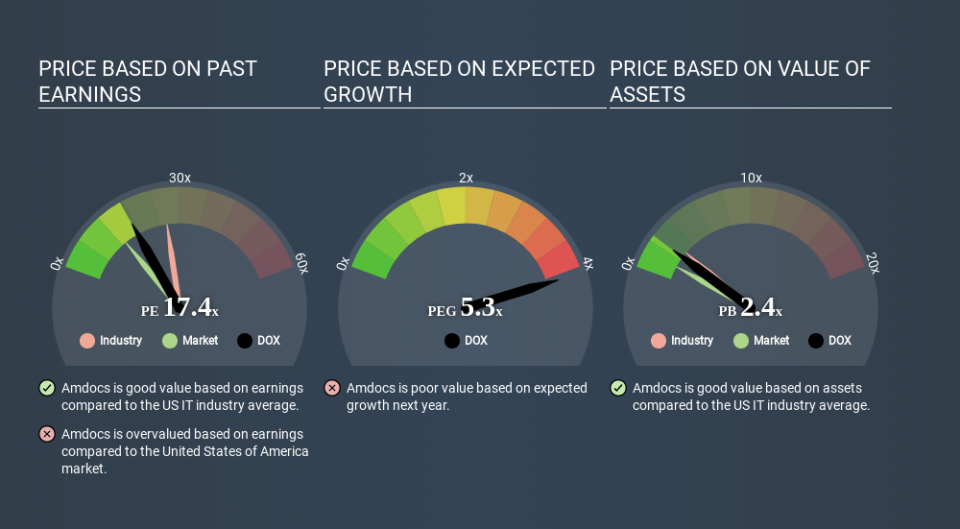A Rising Share Price Has Us Looking Closely At Amdocs Limited's (NASDAQ:DOX) P/E Ratio

Amdocs (NASDAQ:DOX) shareholders are no doubt pleased to see that the share price has bounced 36% in the last month alone, although it is still down 15% over the last quarter. And the full year gain of 17% isn't too shabby, either!
All else being equal, a sharp share price increase should make a stock less attractive to potential investors. While the market sentiment towards a stock is very changeable, in the long run, the share price will tend to move in the same direction as earnings per share. The implication here is that deep value investors might steer clear when expectations of a company are too high. One way to gauge market expectations of a stock is to look at its Price to Earnings Ratio (PE Ratio). Investors have optimistic expectations of companies with higher P/E ratios, compared to companies with lower P/E ratios.
View our latest analysis for Amdocs
How Does Amdocs's P/E Ratio Compare To Its Peers?
We can tell from its P/E ratio of 17.39 that sentiment around Amdocs isn't particularly high. We can see in the image below that the average P/E (26.5) for companies in the it industry is higher than Amdocs's P/E.
Amdocs's P/E tells us that market participants think it will not fare as well as its peers in the same industry. Since the market seems unimpressed with Amdocs, it's quite possible it could surprise on the upside. If you consider the stock interesting, further research is recommended. For example, I often monitor director buying and selling.
How Growth Rates Impact P/E Ratios
Generally speaking the rate of earnings growth has a profound impact on a company's P/E multiple. That's because companies that grow earnings per share quickly will rapidly increase the 'E' in the equation. That means unless the share price increases, the P/E will reduce in a few years. A lower P/E should indicate the stock is cheap relative to others -- and that may attract buyers.
Amdocs's earnings made like a rocket, taking off 51% last year. Having said that, if we look back three years, EPS growth has averaged a comparatively less impressive 9.8%.
Remember: P/E Ratios Don't Consider The Balance Sheet
It's important to note that the P/E ratio considers the market capitalization, not the enterprise value. Thus, the metric does not reflect cash or debt held by the company. Hypothetically, a company could reduce its future P/E ratio by spending its cash (or taking on debt) to achieve higher earnings.
While growth expenditure doesn't always pay off, the point is that it is a good option to have; but one that the P/E ratio ignores.
How Does Amdocs's Debt Impact Its P/E Ratio?
Since Amdocs holds net cash of US$486m, it can spend on growth, justifying a higher P/E ratio than otherwise.
The Bottom Line On Amdocs's P/E Ratio
Amdocs trades on a P/E ratio of 17.4, which is above its market average of 13.6. The excess cash it carries is the gravy on top its fast EPS growth. So based on this analysis we'd expect Amdocs to have a high P/E ratio. What we know for sure is that investors have become more excited about Amdocs recently, since they have pushed its P/E ratio from 12.8 to 17.4 over the last month. If you like to buy stocks that have recently impressed the market, then this one might be a candidate; but if you prefer to invest when there is 'blood in the streets', then you may feel the opportunity has passed.
Investors should be looking to buy stocks that the market is wrong about. People often underestimate remarkable growth -- so investors can make money when fast growth is not fully appreciated. So this free visualization of the analyst consensus on future earnings could help you make the right decision about whether to buy, sell, or hold.
You might be able to find a better buy than Amdocs. If you want a selection of possible winners, check out this free list of interesting companies that trade on a P/E below 20 (but have proven they can grow earnings).
If you spot an error that warrants correction, please contact the editor at editorial-team@simplywallst.com. This article by Simply Wall St is general in nature. It does not constitute a recommendation to buy or sell any stock, and does not take account of your objectives, or your financial situation. Simply Wall St has no position in the stocks mentioned.
We aim to bring you long-term focused research analysis driven by fundamental data. Note that our analysis may not factor in the latest price-sensitive company announcements or qualitative material. Thank you for reading.

 Yahoo Movies
Yahoo Movies 

